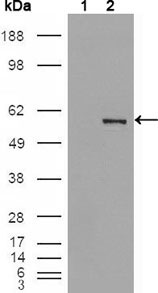ETV4 Antibody
Purified Mouse Monoclonal Antibody
- SPECIFICATION
- CITATIONS
- PROTOCOLS
- BACKGROUND

Application
| WB, E |
|---|---|
| Primary Accession | P43268 |
| Reactivity | Human |
| Host | Mouse |
| Clonality | Monoclonal |
| Clone Names | 1A2G3 |
| Isotype | IgG1 |
| Calculated MW | 54kDa |
| Description | ETV4: ets variant gene 4 (E1A enhancer binding protein, E1AF), also known as PEA3. Several members of the Ets gene family are known to encode sequencespecific DNA binding proteins. These include mouse PU.1, mouse and human Ets-1, Drosophila E74, chicken and human Ets-2 and rat GABP-α. Each of these proteins recognizes similar motifs in DNA that share a centrally located 5'-GGAA-3' element. For instance, PEA3 binds the motif 5'-AGGAAG-3' (the PEA-3 motif), but does not bind to the sequence 5'-AGGAAC-3', recognized by PU.1, although PU.1 binds equally well to both sequences. It appears that all of the Ets proteins recognize the same central core sequence but that each protein interacts with unique sequences that flank this core. PEA3 is expressed at readily detectable levels in cells of epithelial and fibroblastic origin but is not expressed in hematopoietic cells. This is in contrast to other members of the Ets gene family, such as Ets-1, Ets-2 and Fli-1, each of which is expressed primarily in cells of hematopoietic origin. |
| Immunogen | Purified recombinant fragment of human ETV4 (aa50-109) expressed in E. Coli. |
| Formulation | Ascitic fluid containing 0.03% sodium azide. |
| Gene ID | 2118 |
|---|---|
| Other Names | ETS translocation variant 4, Adenovirus E1A enhancer-binding protein, E1A-F, Polyomavirus enhancer activator 3 homolog, Protein PEA3, ETV4, E1AF, PEA3 |
| Dilution | WB~~1/500 - 1/2000 E~~N/A |
| Storage | Maintain refrigerated at 2-8°C for up to 6 months. For long term storage store at -20°C in small aliquots to prevent freeze-thaw cycles. |
| Precautions | ETV4 Antibody is for research use only and not for use in diagnostic or therapeutic procedures. |
| Name | ETV4 |
|---|---|
| Synonyms | E1AF, PEA3 |
| Function | Transcriptional activator (PubMed:19307308, PubMed:31552090). May play a role in keratinocyte differentiation (PubMed:31552090). |
| Cellular Location | Nucleus {ECO:0000255|PROSITE-ProRule:PRU00237}. |
| Tissue Location | Expressed in keratinocytes. |

Thousands of laboratories across the world have published research that depended on the performance of antibodies from Abcepta to advance their research. Check out links to articles that cite our products in major peer-reviewed journals, organized by research category.
info@abcepta.com, and receive a free "I Love Antibodies" mug.
Provided below are standard protocols that you may find useful for product applications.
References
1. J Biol Chem. 2005 Apr 1;280(13):12503-16. 2. Mol Carcinog. 2006 Sep;45(9):667-75. 3. Oncol Rep. 2006 Jul;16(1):153-8.
If you have used an Abcepta product and would like to share how it has performed, please click on the "Submit Review" button and provide the requested information. Our staff will examine and post your review and contact you if needed.
If you have any additional inquiries please email technical services at tech@abcepta.com.













 Foundational characteristics of cancer include proliferation, angiogenesis, migration, evasion of apoptosis, and cellular immortality. Find key markers for these cellular processes and antibodies to detect them.
Foundational characteristics of cancer include proliferation, angiogenesis, migration, evasion of apoptosis, and cellular immortality. Find key markers for these cellular processes and antibodies to detect them. The SUMOplot™ Analysis Program predicts and scores sumoylation sites in your protein. SUMOylation is a post-translational modification involved in various cellular processes, such as nuclear-cytosolic transport, transcriptional regulation, apoptosis, protein stability, response to stress, and progression through the cell cycle.
The SUMOplot™ Analysis Program predicts and scores sumoylation sites in your protein. SUMOylation is a post-translational modification involved in various cellular processes, such as nuclear-cytosolic transport, transcriptional regulation, apoptosis, protein stability, response to stress, and progression through the cell cycle. The Autophagy Receptor Motif Plotter predicts and scores autophagy receptor binding sites in your protein. Identifying proteins connected to this pathway is critical to understanding the role of autophagy in physiological as well as pathological processes such as development, differentiation, neurodegenerative diseases, stress, infection, and cancer.
The Autophagy Receptor Motif Plotter predicts and scores autophagy receptor binding sites in your protein. Identifying proteins connected to this pathway is critical to understanding the role of autophagy in physiological as well as pathological processes such as development, differentiation, neurodegenerative diseases, stress, infection, and cancer.



